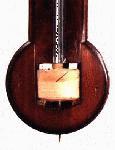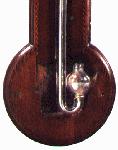
Barometers can be moved around successfully, but care must be taken to prevent (a) air from entering the mercury tube, (b) mercury from being lost, or (c) the rather fragile glass tube from being broken. Charles Edwin Inc. offers these instructions to help you prepare your barometer for a short or long move.
SHORT MOVE. Nearly any barometer can be safely moved for a short distance without special preparation, just by taking the barometer off its hanger, tilting it slightly to make the mercury rise to the top of the glass tube, and carrying it slowly and smoothly to a safe place. Keep it tilted at all times; this will prevent the mercury from surging up and down in the tube and either drawing in a bubble of air, or breaking the end out of the tube. If the barometer is to be stored for a short time, prop it as nearly vertical as possible in a safe corner. Return it to its home on the wall in the same way. Smooth and easy does it. Make no sudden movements.
LONG MOVE. A move to another household is a more serious matter. Probably the best advice is to take the barometer in the car yourself, and don't let the movers touch it. If there's no way to avoid giving the barometer to the movers, prepare it as described below and then supervise while the packers pad a wardrobe box with pillows and pack the barometer in the proper position inside. Surround it with pillows so it can't shift during handling.
There are several types of barometer, and each has to be moved in a slightly different manner to protect it. Links are to pictures in our catalog-- don't forget to come back.
BANJO (DIAL or WHEEL) BAROMETERS
Banjo barometers all
have essentially the same form of mercury system. To prepare one for
a long-distance move, you'll need two size 00 or 000 corks, which can
be found at hobby and hardware stores, and a little masking tape. Take
the barometer gently off the wall, turn its back toward you, and set
it on an upholstered chair or couch, tilted 45 degrees off of  vertical.
vertical.
STICK BAROMETERS
Stick, or straight-tube barometers are made so that you read the mercury directly from the top of the visible glass tube. They will generally have either of two types of mercury reservoir (cistern) at the bottom of the glass tube: a cylindrical wood cistern with a closing screw, or a glass bulb. To determine which you have, you'll probably have to remove the round wood cistern cover from the bottom of the case. It will either pull straight off forward, being held on by two small brass pins in the wood, or will have to be removed by turning the case around and taking two screws out of the rear. Keep the barometer upright while you do this.
 Wood
cistern with closing screw. The cylindrical cistern, or reservoir
of mercury, is sealed to the bottom end of the glass tube, and also
has a leather diaphragm in its base. The closing screw, more properly
called the portable screw, is a threaded brass rod that protrudes
from the bottom of the barometer. When the screw is turned upward, it
compresses the diaphragm and expells some of the air from the cistern.
Wood
cistern with closing screw. The cylindrical cistern, or reservoir
of mercury, is sealed to the bottom end of the glass tube, and also
has a leather diaphragm in its base. The closing screw, more properly
called the portable screw, is a threaded brass rod that protrudes
from the bottom of the barometer. When the screw is turned upward, it
compresses the diaphragm and expells some of the air from the cistern.
Take the barometer gently off the wall and tilt it
slowly back, to about 45 degrees. The mercury will rise in the glass
tube and fill the empty space at the top. With the instrument still
tilted, turn the closing screw clockwise until you have pushed the leather
diaphragm upward about one-quarter inch.
Don't force the screw, or you may tear the leather out of the cistern.
The barometer should now be gently laid flat, and kept horizontal until
you are ready to hang it again. When you get the barometer to its new
home, hang it on the wall and then open the closing screw as far as
it will go.
Note: Ships' barometers work with a wood cistern as above, but the closing screw (on those that have one, they don't all) is not readily visible, being inside the brass cylinder on the bottom of the case. Take the barometer out of its gimbal mount and tilt it gently and very slowly, giving the vacuum space at the top of the tube all the time it needs to fill completely. Ships' barometers should have a glass tube that sharply restricts the movement of the mercury, and it will flow very slowly. (This feature allowed them to be used on ships in rough seas, protecting the fragile glass tube from surging masses of mercury.) Now unscrew the very bottom cap of the brass cylinder, uncovering the knob of the closing screw, and then turn the screw upward against the leather as described above. Again, transport the barometer laying flat. If your ship's barometer doesn't have a closing screw, just let the tube fill completely up at the top and then lay the barometer nearly horizontal, with the top slightly elevated, to transport it.
 Glass
bulb cistern. Stick barometers without a wood cistern and closing
screw have a glass tube that is bent in a short "J" shape
at the bottom. The short leg of the "J", which is behind the
removable wooden cistern cover on the bottom of the case, is topped
with a glass bulb about half full of mercury, with an open spout. With
the barometer in your hands, held vertical, and the cistern cover off,
tilt the barometer back slowly and let the top of the tube fill with
mercury. Then cork the open spout so the mercury can't splash out. A
size 00 or 000 cork will do, and can be found at hobby shops or hardware
stores. If you can't find a suitable cork, plug the open end of the
tube with a cotton ball and tape it over very thoroughly. Carry the
barometer in the car at a 45 degree tilt only; never lay it flat.
It will travel safely if you prop it in the back seat with pillows,
and cushion the bottom end against sharp bumps.
Glass
bulb cistern. Stick barometers without a wood cistern and closing
screw have a glass tube that is bent in a short "J" shape
at the bottom. The short leg of the "J", which is behind the
removable wooden cistern cover on the bottom of the case, is topped
with a glass bulb about half full of mercury, with an open spout. With
the barometer in your hands, held vertical, and the cistern cover off,
tilt the barometer back slowly and let the top of the tube fill with
mercury. Then cork the open spout so the mercury can't splash out. A
size 00 or 000 cork will do, and can be found at hobby shops or hardware
stores. If you can't find a suitable cork, plug the open end of the
tube with a cotton ball and tape it over very thoroughly. Carry the
barometer in the car at a 45 degree tilt only; never lay it flat.
It will travel safely if you prop it in the back seat with pillows,
and cushion the bottom end against sharp bumps.
Admiral Fitzroy barometers are actually a type of stick barometer, and have large, visible bulb cisterns, behind the front glass, that work as described above. If the barometer was made with a closing device and plug (and by some miracle it is still working) you can get at the lever that works the closer from the back of the case and drive the cork down into the open end of the bulb. Don't use a lot of force. If the tube is open and no closing device is visible, take the bottom wood moulding off of the barometer via the screws up through the bottom side, slide the glass panel down and out of the case, and cork the open end of the tube. Carry the Fitzroy at a 45 degree angle also, no matter what type of closer it has.
There are many variations of these, and some have closing screws either inside or outside their brass cistern assemblies while others have no method for making them portable at all, or a method so obscure that only a specialist can work out how to make it operate. They all seem to have two things in common: (a) their glass mercury tubes are ridiculously fragile, and (b) the cistern closing assembly is better left untouched unless you really know what you are about. The best advice we can give is to just tilt the barometer slowly and gently to 45 degrees and let the top of the tube fill with mercury, then transport the barometer at that angle. Be sure to wrap the barometer in a good, stout plastic bag to contain any possible mercury spills, and cushion it well. The mercury system in these barometers is nearly always sealed against loss, but the glass tubes can break.
THINGS TO REMEMBER ABOUT BAROMETERS
Charles Probst,
1 August 1996
![]()